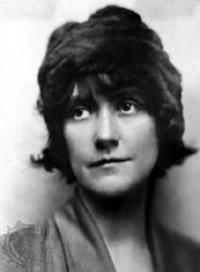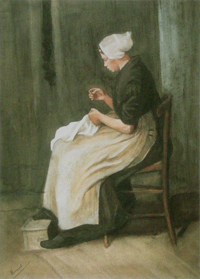
Source: Susan Glaspell, Wikipedia

Source: Woman Sewing, Wikipedia
The play Trifles, written in 1916 by Susan Glaspell, is about an event that occurred while she was a reporter working for the Des Moines Daily News. Her one-act play covers a day in a farming community after a murder is committed. In the play, John Wright is found strangled to death in his bed with a rope around his neck. Authorities arrest his wife, the only suspect, and take her into custody. The sheriff, county attorney, and Mr. Hale (a neighboring farmer) gather at Wright’s house to search for evidence that will close the case on his wife. Mrs. Peters (the sheriff’s wife) and Mrs. Hale join them. The men are dismissive of the women who discuss how concerned Mrs. Wright was over household issues even as she was taken to jail. The men label their observations and questions “trifles,” suggesting that the women’s concerns are not important. They also make fun of the women’s discussion about quilting techniques and whether Mrs. Wright was going to quilt her pieces of fabric or knot them.
SHERIFF
They wonder if she was going to quilt it or just knot it! (The men laugh, the women look abashed)
While the men leave the house to search for clues elsewhere, the women are left alone onstage. The dramatic irony occurs when they find the evidence that would help to convict Mrs. Wright: quilt squares stitched in a haphazard fashion, suggesting Mrs. Wright was distracted or worried and incapable of sewing as neatly as she always had. They find a box containing Mrs. Wright’s pet canary that, like her husband, has also been strangled. Through their conversation, the two women inform the audience that Mr. Wright was a cruel husband. They believe he killed the canary in anger. The audience now understands that Mrs. Wright has a motive for murdering her husband. In the excerpt you’re about to read, the men return to the room, and the audience knows that Mrs. Wright may be guilty of killing her husband.
COUNTY ATTORNEY
No, Peters, it’s all perfectly clear except a reason for doing it. But you know juries when it comes to women. If there was some definite thing. Something to show—something to make a story about—a thing that would connect up with this strange way of doing it—
(The women’s eyes meet for an instant. Enter HALE from outer door)
SHERIFF
I just want you to come in here a minute, George. We ought to take a look at these windows.
COUNTY ATTORNEY
(scoffingly) Oh windows!
SHERIFF
We’ll be right out, Mr. Hale. (HALE goes outside. The SHERIFF follows the COUNTY ATTORNEY into the other room. Then MRS. HALE rises, hands tight together, looking intensely at MRS. PETERS, the sheriff’s wife, whose eyes make a slow turn, finally meeting MRS. HALE’s. A moment MRS. HALE holds her, then her own eyes point the way to where the box is concealed. Suddenly MRS. PETERS throws back quilt pieces and tries to put the box in the bag she is carrying. It is too big. She opens the box, starts to take the bird out, cannot touch it, goes to pieces, stands there helpless. Sound of a knob turning in the other room. MRS. HALE snatches the box and puts it in the pocket of her big coat. Enter COUNTY ATTORNEY and SHERIFF.)
COUNTY ATTORNEY
(facetiously) Well, Henry, at least we found out that she was not going to quilt it. She was going to—what do you call it, ladies?
MRS. HALE
(her hand against her pocket) We call it "knot it," Mr. Henderson.
The audience knows that the women have hidden the evidence in order to protect Mrs. Wright. The last line refers not only to trifles—women’s needlework—but also to the rope that was used to kill Mr. Wright. In this case, dramatic irony is created when the audience becomes privy to the evidence that the women have but the men are unable to find.
 Using your notes, answer the following questions about the excerpt. When you’re finished, check your understanding to see a possible response.
Using your notes, answer the following questions about the excerpt. When you’re finished, check your understanding to see a possible response.- How do you feel knowing that the women have knowledge about the murder but don’t share it with the men?
- How is dramatic irony created in the scene you read?
- In this play, the audience will feel sorry for Mrs. Wright, especially after the women find the dead canary; for this reason, we are glad that the women withhold the evidence.
- The dramatic irony is created when the audience becomes privy to the knowledge that the two women are hiding evidence that the men in the play need in order to convict Mrs. Wright. After learning that Mr. Wright was possibly a cruel husband, we are sympathetic toward Mrs. Wright and secretly root for the women who are hiding the evidence. Also, we know what the men in the play don’t, which creates dramatic irony.